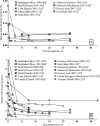Retinol-to-Fat Ratio and Retinol Concentration in Human Milk Show Similar Time Trends and Associations with Maternal Factors at the Population Level: A Systematic Review and Meta-Analysis
- PMID: 29846525
- PMCID: PMC6008956
- DOI: 10.1093/advances/nmy021
Retinol-to-Fat Ratio and Retinol Concentration in Human Milk Show Similar Time Trends and Associations with Maternal Factors at the Population Level: A Systematic Review and Meta-Analysis
Abstract
Vitamin A in human milk is critical for meeting infant requirements and building liver stores needed after weaning. A number of studies have measured milk retinol, but only a subset have corrected for fat, which serves as the retinol carrier in breast milk. The purpose of the present work was to review and analyze studies in which human-milk retinol concentrations were reported in relation to milk fat and to compare these results with unadjusted breast-milk retinol concentrations in terms of time trends over the course of lactation, influences of maternal nutritional and constitutional factors, and effects of maternal vitamin A supplementation. A systematic approach was used to search the available literature by using the US National Library of Medicine's MEDLINE/PubMed bibliographic search engine. Observational and intervention studies were included if the research was original and the retinol-to-fat ratio (retinol:fat) in human milk was measured at ≥1 time point during the first 12 mo of lactation. Retinol:fat and retinol were highest in colostrum, declined rapidly in early lactation, and achieved statistical stability by 2 and 4 wk lactation, respectively. In mature milk, retinol concentration was positively correlated with milk fat (r = 0.61, P = 0.008). Breast-milk retinol:fat and retinol were positively associated with maternal vitamin A intake but were associated with plasma retinol only when dietary intake was inadequate. Postpartum supplementation with high-dose vitamin A (200,000-400,000 IU) resulted in significantly higher breast-milk retinol:fat for 3 mo and retinol for 6 mo (P < 0.05). In populations, the 2 indexes show similar trends and associations with maternal factors. Future studies should monitor how the uptake of retinol into the mammary gland affects maternal vitamin reserves, particularly in women who are at risk of vitamin A deficiency.
Figures


References
-
- Institute of Medicine, Food and Nutrition Board Dietary Reference Intakes for Vitamin A, Vitamin K, Arsenic, Boron, Chromium, Copper, Iodine, Iron, Manganese, Molybdenum, Nickel, Silicon, Vanadium, and Zinc. Washington (DC): National Academies Press; 2001. - PubMed
-
- Debier C, Larondelle Y. Vitamins A and E: metabolism, roles and transfer to offspring. Br J Nutr 2005;93:153–74. - PubMed
Publication types
MeSH terms
Substances
LinkOut - more resources
Full Text Sources
Other Literature Sources
Medical

